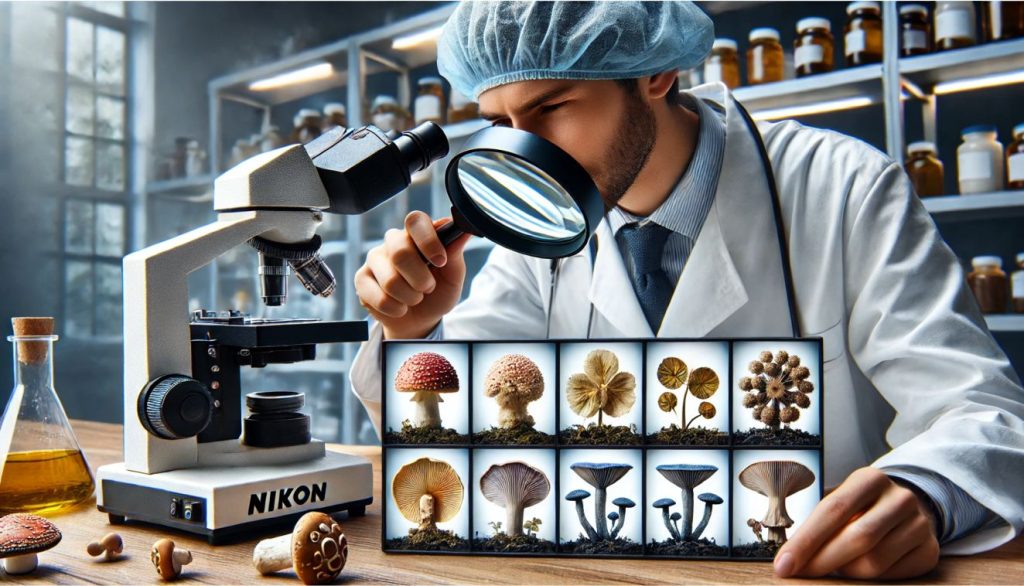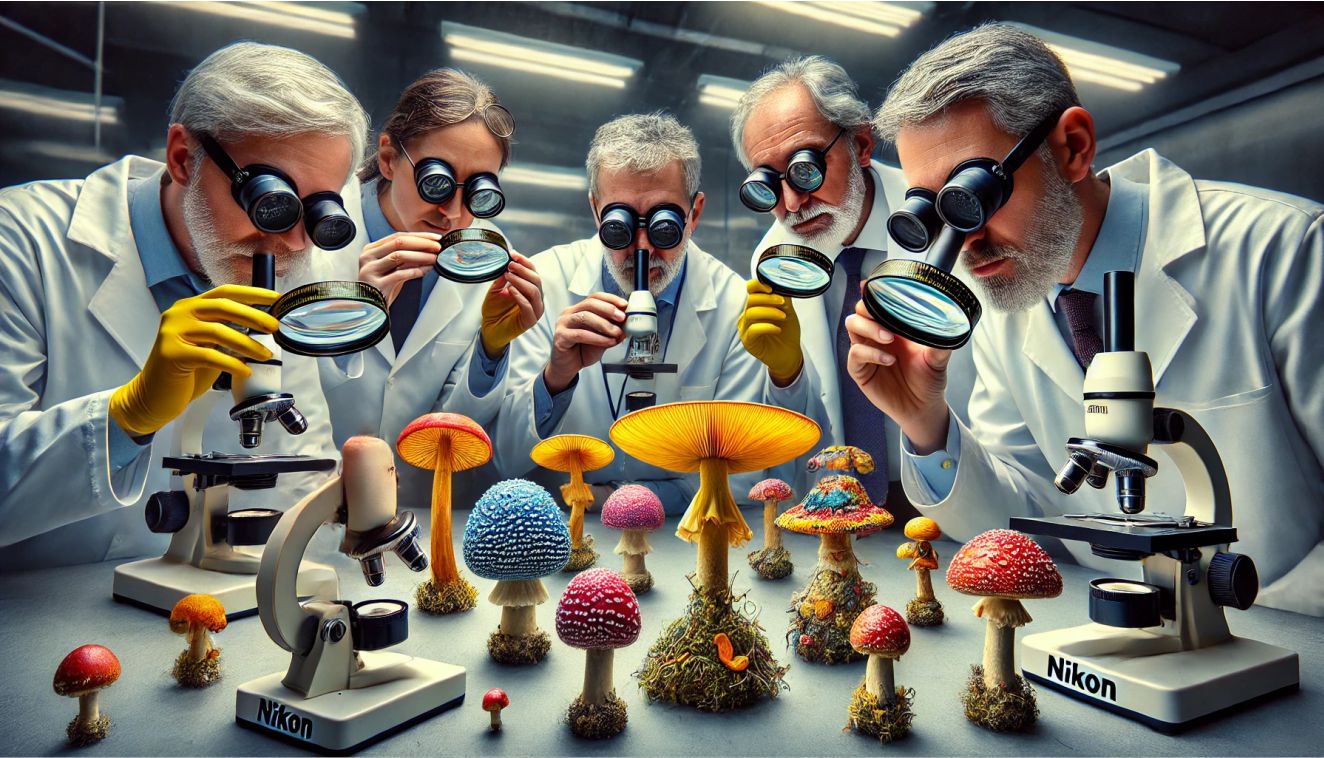Have you ever stumbled upon a strangely shaped mushroom in your backyard and wondered, “Is that magic?” Well, you’ve landed in the right place!
Psilocybin mushrooms are classified as a Schedule I controlled substance under the Controlled Substances Act, indicating their illegal status and potential for abuse.
Identifying Magic Mushrooms: Nature’s Trippy Treat (or Trouble)?
There are over 40 known species of psilocybin-containing mushrooms, and some look scarily similar to their highly poisonous doppelgangers. So, before you go mushroom hunting, you should first understand what to look for.
Psilocybe: The Magic Name Behind Psilocybin Mushrooms
Our journey takes us down the path of the genus psilocybe. It is the most common group of mushrooms containing psilocybin, the psychoactive compound responsible for the mind-bending effects associated with magic mushrooms. Psilocybe cubensis, a significant species within this genus, is renowned for its psychoactive properties. Psilocybin works by interacting with serotonin receptors in the brain, leading to alterations in perception, mood, and thought patterns.
The Allure of Identification: A Visual Guide (with Caution)
Now, the fun part – identifying hallucinogenic mushrooms, including magic mushrooms! But hold on to your magnifying glass! While some physical characteristics might point you in the right direction, relying solely on appearance is a recipe for disaster. Here’s a sneak peek at some potential identifiers:
- Genus Psilocybe: They often have a distinctive cap shape, ranging from conical to bell-shaped with a pointed nipple in the center (technical term: umbo). The cap color varies from light brown to golden yellow, and some species even have a bluish tint.
- Spores: Spores are the reproductive units of mushrooms, and their color may be a helpful clue. Psilocybe mushrooms typically have dark-colored spores, appearing purple-brown to black when deposited as a spore print on paper. However, spore color alone isn’t a foolproof identifier, and some poisonous mushrooms share that characteristic.
- Gills: Take a peek underneath the cap. The gills, the thin structures responsible for spore production, are often described as attached to the stem in psilocybe mushrooms. They could be various shades of brown, gray, or even purple.
Why Identification is a Delicate Dance
All the physical characteristics may be misleading. Many poisonous mushrooms mimic the appearance of psilocybe mushrooms. One wrong move and a fun-filled adventure could turn into a trip to the emergency room. That’s why relying solely on looks is a risky gamble.
The Importance of Respect and Reliable Resources
Psilocybin mushrooms are a force to be reckoned with. The fungi hold immense therapeutic potential, with ongoing research exploring their use in treating conditions like depression, anxiety, and addiction. However, they may also be dangerous if not handled with respect. A historical resource for cultivation and identification is the ‘magic mushroom grower’s guide’ by Terence and Dennis McKenna. In the next section, we’ll explore some of the dangers associated with misidentification and get into reliable resources to help you navigate the world of magic mushrooms safely.
Dangerous Look-Alikes and the Path to Safe Identification

You find a mushroom that seems to tick all the psilocybe boxes – the right cap shape, dark spores, and attached gills. But what if it’s not what it seems? The world of fungi is full of imposters, and some poisonous mushrooms closely resemble psilocybe. The genus Pluteus includes a few species that are psilocybin-producing, such as Pluteus atricapillus and Pluteus cyanopus. Here are a few notorious examples:
- Galerina marginata: A look-alike that shares the psilocybe’s brown, conical cap and dark spores. However, unlike psilocybe, Galerina marginata lacks a partial veil (a thin membrane that covers the young gills) and may cause severe organ damage if ingested.
- Conocybe filaris: The slender mushroom sports a brown, pointed cap and dark spores, mimicking some psilocybe species. However, Conocybe filaris contains toxins that lead to nausea, vomiting, and even seizures.
The key takeaway? Relying solely on appearance is a gamble you don’t want to take.
Telltale Signs To Look Out For (But Not Rely on Them Solely)
While appearance isn’t the ultimate identifier, some additional characteristics might offer clues for identifying hallucinogenic species:
- Bruising: Some psilocybe mushrooms bruise blue or purple when handled. However, it isn’t a universal characteristic, and some poisonous mushrooms exhibit the same behavior.
- Habitat: Knowing where to look may be helpful. Psilocybe mushrooms often favor damp, grassy areas or mulched wood chips. However, that isn’t a definitive indicator, and other mushrooms thrive in similar environments.
Reliable Resources for Identification
So, how do you avoid a brush with danger while exploring the world of psilocybe mushrooms? Here are some reliable resources to guide you:
- Field Guides: Invest in a reputable field guide specifically focused on psilocybe mushrooms that provides detailed descriptions, photographs, and spore prints for various psilocybe species.
- Mushroom Hunting Clubs: Consider joining a local mushroom hunting club, some of which often organize outings led by experienced mycologists (fungus experts) who help you identify mushrooms safely.
- Online Resources (with Caution): There are online resources dedicated to psilocybe identification. However, approach with caution. Double-check information with trusted sources, and remember, pictures on a screen may be deceiving.
The Importance of Expert Consultation
Here’s the bottom line: even with reliable resources, identifying magic mushrooms in the wild requires a keen eye and a healthy dose of respect. When in doubt, always err on the side of caution. Consider consulting a professional mycologist for a definitive identification before consuming any wild mushroom.
Remember, your safety is paramount. In the next and final section, we’ll explore some of the potential effects of consuming magic mushrooms and the legalities surrounding them.
Real Effects of Magic Mushrooms
Psilocybin, the psychoactive compound in psychedelic mushrooms, interacts with serotonin receptors in the brain, leading to a range of effects, often referred to as a “trip.” Here’s a glimpse into the potential effects:
- Hallucinations: That is what magic mushrooms are most famous for. Users may experience visual and auditory hallucinations, seeing or hearing things that aren’t there.
- Altered Perception: The way you perceive the world around you could be distorted. Time and space may seem to bend, and colors may appear more vibrant.
- Mood Swings: Emotions fluctuate during a trip. Euphoria, peacefulness, and a sense of connection are common, but anxiety, fear, and paranoia also occur.
- Introspection: Magic mushrooms trigger deep introspection, leading to profound insights and a heightened sense of self-awareness.
Risks and Potential Dangers
Remember that magic mushrooms are not for everyone. Here are some potential risks and dangers to consider:
- Bad Trips: A bad trip may be a frightening experience, characterized by intense anxiety, paranoia, and even hallucinations of a disturbing nature.
- Psychological Issues: For people with pre-existing mental health conditions, magic mushrooms may worsen symptoms like anxiety and psychosis.
- Addiction: While not physically addictive, some users may develop a psychological dependence on magic mushrooms.
The sacred mushroom, also known as Psilocybe cubensis, holds cultural and historical significance in various regions. In Australia, it is commonly referred to as gold top or golden top, while in Brazil, it is known as the sacred mushroom or blue mushroom. In the United States and Mexico, it is often called the San Ysidro or Palenque mushroom.
The Legal Lowdown: A Patchwork of Laws
The legal status of magic mushrooms varies widely around the world. In many countries, including the United States, psilocybin is classified as a Schedule I controlled substance, meaning it has a high potential for abuse and no currently accepted medical use. However, some jurisdictions are exploring the therapeutic potential of psilocybin, and research is ongoing.
The Final Word: Respect, Safety, and Responsible Exploration
The world of magic mushrooms is a fascinating one, but it’s important to approach it with respect and caution. Safe identification is paramount, and consulting a professional is always recommended before consuming any wild mushroom. Remember, your safety is the top priority.
FAQs on Magic Mushrooms
Now that we’ve explored the world of magic mushrooms, let’s answer some burning questions you might have:
Can I identify magic mushrooms myself based on looks alone?
No, relying solely on appearance is extremely dangerous. Many poisonous mushrooms closely resemble psilocybe mushrooms.
What are some dangers of mistaking poisonous mushrooms for a magic mushroom?
Ingesting a poisonous mushroom may lead to severe illness, organ damage, or even death. Symptoms range from nausea and vomiting to hallucinations, seizures, and coma.
Are there any reliable resources to help identify magic mushrooms safely?
Here are some resources, but remember, even with them, consulting a mycologist is ideal:
- Reputable Field Guides: Invest in a psilocybe-specific guide with detailed descriptions, pictures, and spore prints.
- Mushroom Hunting Clubs: Join a club with experienced mycologists to guide you in safe identification.
- Online Resources (Use with Caution): Double-check information with trusted sources and remember, pictures may be deceiving.
What are some physical characteristics that distinguish magic mushrooms from other types?
Some potential identifiers (not foolproof!) include:
- Cap Shape: Psilocybe mushrooms often have conical or bell-shaped caps with a pointed nipple.
- Spore Color: They typically have dark-colored spores, appearing purple-brown to black.
- Gills: The gills are usually attached to the stem and may be brown, gray, or purple.
Can I use a spore print to identify magic mushrooms?
Spore color could be a clue, but it’s not definitive. Some poisonous mushrooms share the same spore color as psilocybe.
What are the legal risks associated with possessing magic mushrooms?
The legal status of magic mushrooms varies by location. In many places, psilocybin is a controlled substance. Always check your local laws.
If I find magic mushrooms, how I be sure they haven’t been contaminated?
There’s no way to be 100% sure without professional identification. Wild mushrooms may be contaminated with bacteria, mold, or other harmful substances.
What are some of the potential effects of consuming magic mushrooms?
Potential effects include hallucinations, altered perception, mood swings, and introspection. There are also risks of bad trips, psychological issues, and addiction.
Are there any dangers associated with using magic mushrooms alongside other substances?
Yes, mixing magic mushrooms with alcohol, other drugs, or certain medications is dangerous and leads to unpredictable interactions.



